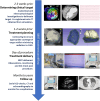Radiation therapy for ventricular arrhythmias
- PMID: 38698577
- PMCID: PMC11686466
- DOI: 10.1111/1754-9485.13662
Radiation therapy for ventricular arrhythmias
Abstract
Ventricular arrhythmias (VA) can be life-threatening arrhythmias that result in significant morbidity and mortality. Catheter ablation (CA) is an invasive treatment modality that can be effective in the treatment of VA where medications fail. Recurrence occurs commonly following CA due to an inability to deliver lesions of adequate depth to cauterise the electrical circuits that drive VA or reach areas of scar responsible for VA. Stereotactic body radiotherapy is a non-invasive treatment modality that allows volumetric delivery of energy to treat circuits that cannot be reached by CA. It overcomes the weaknesses of CA and has been successfully utilised in small clinical trials to treat refractory VA. This article summarises the current evidence for this novel treatment modality and the steps that will be required to bring it to the forefront of VA treatment.
Keywords: ablation; non‐invasive; radiosurgery; stereotactic body radiation therapy; ventricular arrhythmias.
© 2024 The Authors. Journal of Medical Imaging and Radiation Oncology published by John Wiley & Sons Australia, Ltd on behalf of Royal Australian and New Zealand College of Radiologists.
Conflict of interest statement
Verity Ann Ahern is an Editorial Board member of JMIRO and a co‐author of this article. To minimise bias, they were excluded from all editorial decision‐making related to the acceptance of this article for publication.
Figures



References
-
- Viles‐Gonzalez JF, Arora S, Deshmukh A et al. Outcomes of patients admitted with ventricular arrhythmias and sudden cardiac death in the United States. Heart Rhythm 2019; 16: 358–366. - PubMed
-
- Wei C, Boeck M, Qian PC et al. Cost of cardiac stereotactic body radioablation therapy versus catheter ablation for treatment of ventricular tachycardia. Pacing Clin Electrophysiol 2022; 45: 1124–1131. - PubMed
Publication types
MeSH terms
Grants and funding
LinkOut - more resources
Full Text Sources
Medical

